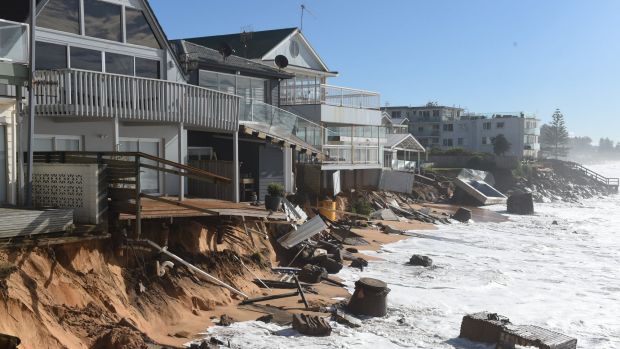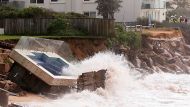Next week, Suncorp will reveal its half-year results and will likely maintain an embarrassing record for the company.
Last year, natural hazard claims exceeded provisions for the ninth year in 10, costing the major insurer $2 billion more than budgeted. Bell Potter analysts have now estimated another $40 million loss for the first half of the 2016-17 financial year, with the severe storms experienced in South Australia and Victoria the primary culprits.
More World News Videos
A crazy year of world weather
From the monster storm that wiped 50m of sand from Collaroy Beach to the deadly wildfires in Tennessee, here is a look at the weather events that shaped 2016.
Suncorp chairman Ziggy Switkowski and former chief executive Patrick Snowball previously pointed out that the amount budgeted for natural hazard claims is never going to be right.
In some years you'll provision too much and in others, too little. Sure, this isn't The Price is Right – but under provisioning nine years in 10 and tracking to do the same again this year? Not a good look.
This isn't about just picking on Suncorp, because the big three general insurers are in the same situation. Rivalling Suncorp, IAG's natural hazard claims have exceeded provisions eight years out of 10 and while QBE's numbers are a little more opaque, their net losses from catastrophes have exceeded more than $US1.5 billion in just five years. That's no good for shareholders, nor can it be any good for premiums.
Model fail
So what's actually going on? Clearly some of the quantitative work and modelling is failing, even after Snowball introduced a "management overlay" on natural hazard provisions – which sounds suspiciously like whacking another 10 per cent on top of the allocated amount to cover the assumption they've got it wrong.
But the trend towards more intense severe weather events should hardly be a surprise. It's exactly what climate change scientists have been predicting for decades. So where is the insurance industry on this issue?
Amazingly, if you go back 10 years, one of our insurers was at the forefront of climate discussion and advocacy efforts from within business circles. Michael Hawker, IAG's chief executive at the time, was an outspoken advocate for strong action on climate change, warning that insurers would struggle to calculate and manage the risk of natural hazards if global warming worsened. So far he has been spot on.

So what happened? It seems that as climate change shifted from theoretical risk to real and present danger, it became a much more difficult conversation. As parts of Queensland became uninsurable for flood damage, the major general insurers stopped talking about the impact climate change would have on coverage and premiums, and instead focused on "resilience", i.e. building standards.
The Insurance Council of Australia has been virtually mute, quietly releasing a carefully worded position statement last August, without so much as a media release.

Millions exposed
But running a hasty retreat isn't acceptable from an industry that should be built on the data and research we need and that we employ to have our backs covered. Millions of Australians are exposed to risk of injury, financial loss or property damage from events forecast to become more intense and more common due to climate change.
Think you're covered? Think again. Ask the residents of Collaroy in Sydney's Northern Beaches who last year learned the hard way that they weren't covered for the Pacific Ocean chewing off parts of their backyards and homes.

While local MP Brad Hazzard derided insurers for "ducking and hiding" behind their policies, the fact that great swathes of waterfront Sydney properties remain unprotected from sea-level rise, seems to have been ignored.
Rejoining the debate isn't going to be fun, especially in light of the fact that natural hazard claims aren't the only way insurers are exposed to climate change. All insurers are to varying degrees exposed to fossil fuels through their investment portfolios and QBE and Suncorp are actively underwriting the infrastructure and property of the fossil fuel sector. They are in fact undermining their own profitability by perpetuating the very activities that are driving these repeated natural hazard claim blowouts.
If the insurance sector needed someone else to point out this fairly embarrassing contradiction, you're welcome. But now it's time to roll up your sleeves again and get back to the forefront of the debate.
Waiting for the rest of Australia, not just the people of Collaroy, to learn they have no financial recourse when sea-level rise and storm surges threaten their homes, or for governments to realise they will have to pick up the reconstruction tab when entire communities simply cannot afford insurance, is simply not good enough.
















0 comments
New User? Sign up